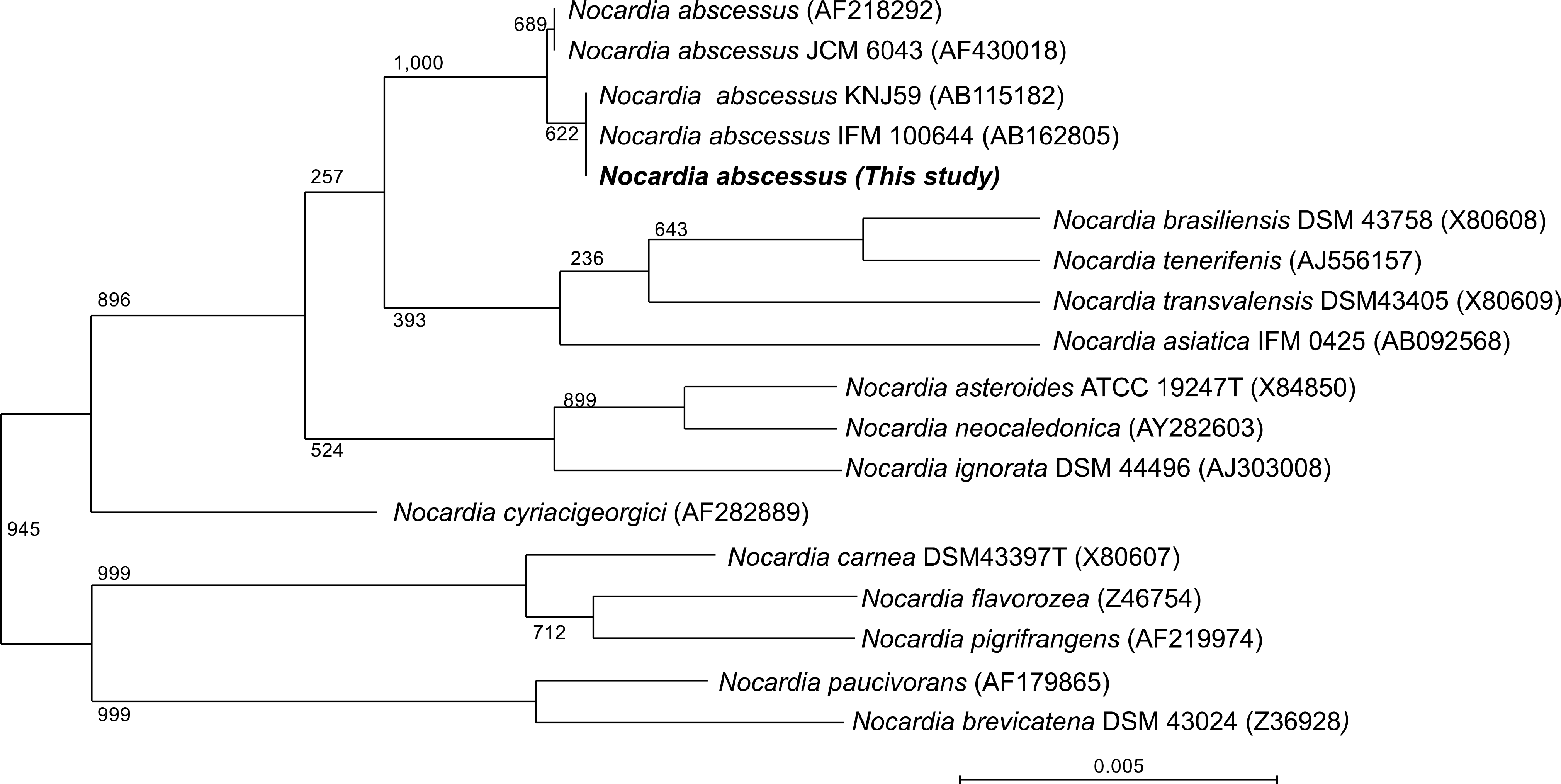Abstract
We describe a cutaneous abscess caused by Nocardia abscessus in a previously healthy woman. A 74-year-old woman presented with recurrent bullae on her left forearm that developed 1 week prior and was initially suspected to be a cutaneous infection with Mycobacteria or Tinea corporis. Histopathologically, the skin lesion formed an abscess. A smear revealed a few branched Gram-positive filamentous microorganisms that formed a creamy white colony on a blood agar plate after incubation for 3 days. The colony tested negative on acid-fast bacilli (AFB) staining, but was positive on modified AFB staining. The isolate was confirmed to be N. abscessus by 16S rRNA sequencing analysis. The isolate was susceptible to trimethoprim-sulfamethoxazole, amikacin, ce-fotaxime and erythromycin but resistant to penicillin. The patient was treated with clarithromycin but subsequently lost to follow-up. To the best of our knowledge, this is the first report of a human cutaneous infection with N. abscessus in Korea.
References
1. Beaman BL and Beaman L. Nocardia species: host-parasite relationships. Clin Microbiol Rev. 1994; 7:213–64.

2. Ambrosioni J, Lew D, Garbino J. Nocardiosis: updated clinical review and experience at a tertiary center. Infection. 2010; 38:89–97.

3. Al Tawfiq JA, Mayman T, Memish ZA. Nocardia abscessus brain abscess in an immunocompetent host. J Infect Public Health. 2013; 6:158–61.

4. Horre R, Schumacher G, Marklein G, Stratmann H, Wardelmann E, Gilges S, et al. Mycetoma due to Pseudallescheria boydii and co-isolation of Nocardia abscessus in a patient injured in road accident. Med Mycobiol. 2002; 40:525–7.
5. Choe WH, Kang JO, Pai HJ, Choi TY. A case of Norcardia asteroids type I induced pneumonia. Ann Lab Med. 2005; 25:324–8.
6. CLSI. Susceptibility testing of mycobacteria, nocardia, and other aerobic actinomycetes; approved standard. CLSI document M24-A. Wayne, PA: Clinical and Laboratory Standards Institute;2003.
Fig. 1.
Phylogenetic tree of the current isolate (CBU 05/1969: 1,362 bp) and Nocardia species. The 16S rRNA gene sequences of Nocardia species available in GenBank were aligned using CLUSTAL V and the phylogenetic tree was generated by the neighbor-joining method. Bootstrap values (%) are shown near their corresponding branches; ‘0.1’ indicates 0.1 nucleotide substitutions per site.

Table 1.
Clinical characteristics and diagnostic tools for the patients with primary cutaneous Nocardiosis in Korea
| Pathogen | Age/ sex | Subtype | Predisposing factors | Underlying disease | Diagnostic tools | Treatment regimen |
|---|---|---|---|---|---|---|
| N. asteroides [8] | 42/F | LC | Traumatic injury | No | Biochemical | TMP/SXT, 6 m |
| N. brasiliensis [9] | 64/M | SC | Chemotherapy | Thymoma | 16S rRNA | TMP/SXT+IMP+AMK |
| N. brasiliensis [10] | 68/M | SC | Traumatic injury | Cardiomyopat | thy 16S rRNA | TMP/SXT, 6 m |
| N. brasiliensis [11] | 68/M | SC | Steroid injection | Cushing synd | drome 16S rRNA | TMP/SXT+CRO, 3 m |
| N. brasiliensis [12] | 56/M | LC | Prednisolone/chemotherapy | Lung cancer | 16S rRNA | TMP/SXT, 6 m |
| N. farcinica [13] | 67/M | Mycetoma | Not described | DM | 16S rRNA | CPD, 4 w+Surgery |
| N. nova [14] | 51/M | LC | Immunosuppressive agents | ESRD | 16S rRNA+secA1 | CRO, 9 w & TMP/SXT, 4 m |
| N. abscessus* | 74/F | SC | Unknown | 16S rRNA | CLM 2 w+Cryoth |
Abbreviations: M, male; F, female; LC, lymphocutaneous; SC, superficial cutaneous; DM, diabetes mellitus; ESRD, end stage of renal disease; 16S rRNA, 16S ribosomal RNA sequencing analysis; secA1, secA1 sequence; TXP/SXT, trimethoprim/sulfamethoxazole; IMP, imipenem; AMK, amikacin; CRO, ceftriaxone; CPD, cefpodoxime; CLM, clarithromycin; Cryoth, Cryotherapy; m, month; w, week.




 PDF
PDF ePub
ePub Citation
Citation Print
Print


 XML Download
XML Download